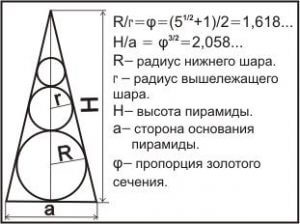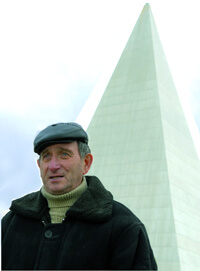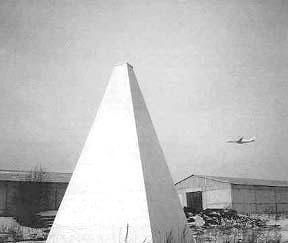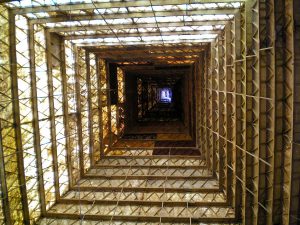
Modern pyramids in Russia (1 part)
 28. 04. 2024
28. 04. 2024

The story of the contemporary Russian pyramids began in 1949, when their designer and builder Alexander Yefimovich Golod was born. The mathematician and engineer has been researching and building pyramids since 1989.
They differ from the ancient Egyptian pyramids, as we know them from Giza, mainly in their shape, they have a narrower base and thus strikingly resemble Nubian pyramids. When constructing his pyramids, Golod used a golden cut - the ratio of the adjacent spiked balls to the pyramid is 1,618 (φ). The height of the pyramid is almost twice as large as the base square.
 They are built of fiberglass or glass-concrete slabs and the buildings do not contain any metal. The height of most pyramids is 11 or 22 meters, the smallest is 5,5 meters high and the largest is 44 meters. For the foundations of the 22-meter pyramid, the slabs are 36 cm thick (its total weight is 25 tons) and for the 44-meter foundations, the slabs are 70 cm thick (weight 55 tons). The highest pyramid, built as the third, is currently the main one, all the later ones have crystals in their foundations, which were grown in this 44-meter building. The pyramids are oriented according to the meridians and one of the edges is directed at the Polar Star. Construction sites are carefully selected and modified.
They are built of fiberglass or glass-concrete slabs and the buildings do not contain any metal. The height of most pyramids is 11 or 22 meters, the smallest is 5,5 meters high and the largest is 44 meters. For the foundations of the 22-meter pyramid, the slabs are 36 cm thick (its total weight is 25 tons) and for the 44-meter foundations, the slabs are 70 cm thick (weight 55 tons). The highest pyramid, built as the third, is currently the main one, all the later ones have crystals in their foundations, which were grown in this 44-meter building. The pyramids are oriented according to the meridians and one of the edges is directed at the Polar Star. Construction sites are carefully selected and modified.
How it all began
Alexandr Golod began as a mathematics teacher, then worked as a programmer; he was also an ordinary employee in senior positions. In 1988,  became in Dnepropetrovsk co-founder of one of the first scientific and production cooperatives focused on agriculture. And here was research into the effects of pyramidal forms on plant seeds. Sunflower, corn, sugar beet and cucumber seeds, previously inhabited in the pyramid, were sown on thousands of hectares of the Zaporozhye and Dnipropetrovsk regions. The results were astounding, the yield was 30-50% higher, the cucumbers did not suffer from any "cucumber" ailments and the plants also survived the drought and acid rain well. The experiment was not limited to Ukraine, Yugoslav scientists joined in with equal success.
became in Dnepropetrovsk co-founder of one of the first scientific and production cooperatives focused on agriculture. And here was research into the effects of pyramidal forms on plant seeds. Sunflower, corn, sugar beet and cucumber seeds, previously inhabited in the pyramid, were sown on thousands of hectares of the Zaporozhye and Dnipropetrovsk regions. The results were astounding, the yield was 30-50% higher, the cucumbers did not suffer from any "cucumber" ailments and the plants also survived the drought and acid rain well. The experiment was not limited to Ukraine, Yugoslav scientists joined in with equal success.
The question arises: if the pyramid has a beneficial effect on plants, how can it affect water, stones, animals and humans? Physicians, biologists, physicists, chemists, mineralogists and even cosmonauts were invited to collaborate.
According to Alexander Golod, the shape of his pyramid is especially favorable for harmonizing the environment and biological organisms.
The first was the construction of an 11-meter pyramid in the Ramen district in the Moscow region and served farmers who grew vegetables in greenhouses. This was followed by a 22-meter pyramid at Lake Seliger, which has the task of draining cyanobacteria and the already mentioned third and highest, 44 m, near Moscow. One of the others (11 m) was placed on the roof of the polyclinic in Tolyatti. drugs are also placed to increase their effectiveness.
In Bashkortia, two complexes of four pyramids were installed at oil wells to reduce the viscosity of oil. Gazprom ordered the Astrakhan plant
several pyramids to extract natural gas wells to improve the environment.
This is followed by pyramids of so-called general use, designed to achieve ecological balance, strengthen the ozone layer and human health. Others are, for example, in the spa of Nizhny Sergi in the Urals, in various towns, but also in some hotels. All pyramids that do not stand on private land are freely accessible to the public.
All this time, not only the construction of pyramids is underway, but also research in various areas. Among other things, experiments were performed by Russian cosmonauts on the International Space Station.





 1
1


